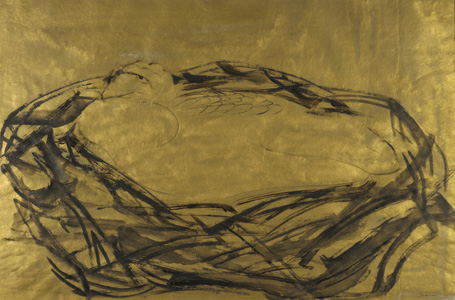
Brooding
Morris Graves
One of America's great mystical painters, Graves was primarily self-taught, although he studied briefly with the like-minded artist mark Tobey. Living and working in the Pacific Northwest, the isolation from artistic centers such as New York or Paris allowed their work to develop largely uninfluenced by dominant trends. Graves and Tobey marked the beginnings of a revival of American abstract art in the 1940s, creating deeply felt, introspective imagery infused with haunting suggestions of emotionality and spirituality.
Deeply influenced by Zen Buddhism and Asian mysticism, Graves' s study of Chinese and Japanese scroll paintings had an even more profound effect on his work than his studies with Tobey. Often using animals, particularly birds, to allude to human psychological states, Graves's work traces a journey through consciousness, which may evoke contemplation, pathos, or a spiritual awakening. In this case, "Brooding" seems to refer not only to the nesting hen's activity, but also to describe her moody expression. In this painting, Graves displayed his mastery of the brush technique of Asian ink painters, in which the simplest stroke of the brush eloquently conveys the maximum meaning. By moderating between wet, bleeding strokes and dry, scratchy marks, Graves added variety and visual meaning in the manner of Japanese master calligraphers.
Artist
Date of Birth
(1910-2001)
Date
1953
Medium
Tempera over bronze powder paint on laid pattern paper
Dimensions
19 7/8 x 30 3/16 in. (50.4825 x 76.67625 cm.)
Accession #
1963.1
Credit Line
Lambert Fund Purchase
Copyright
© artist or artist's estate
Category
Subject
More by
We're so excited you're planning to visit PAFA!
Make time for art — visit us Thursday to Sunday.
Before reserving your tickets, please review helpful information about museum hours, accessibility, building access, and special admission programs.
If you have any questions, feel free to reach out to us at visitorservices@pafa.org — we’d love to help!